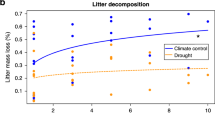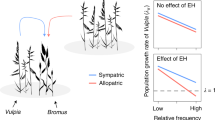Abstract
Diverse experimental plant communities are more productive than monocultures. The increase of this biodiversity effect over time has been attributed to evolutionary selection for complementarity in mixtures. Here we show that evolutionary selection for enhanced net facilitative plant interactions occurred only in mixtures, while evolutionary selection for reduced net competition occurred in mixtures with mixture coexistence history and monocultures with monoculture coexistence history. Widespread declines in natural and agricultural biodiversity could therefore compromise potential evolution of facilitative interactions, that is, cornerstone processes in nature conservation and the development of sustainable agriculture.
This is a preview of subscription content, access via your institution
Access options
Access Nature and 54 other Nature Portfolio journals
Get Nature+, our best-value online-access subscription
$29.99 / 30 days
cancel any time
Subscribe to this journal
Receive 12 digital issues and online access to articles
$119.00 per year
only $9.92 per issue
Buy this article
- Purchase on Springer Link
- Instant access to full article PDF
Prices may be subject to local taxes which are calculated during checkout


Similar content being viewed by others
References
Tilman, D. et al. Science 294, 843–845 (2001).
Loreau, M. & Hector, A. Nature 412, 72–76 (2001).
van Ruijven, J. & Berendse, F. Proc. Natl Acad. Sci. USA 102, 695–700 (2005).
Cardinale, B. J. et al. Proc. Natl Acad. Sci. USA 104, 18123–18128 (2007).
Reich, P. B. et al. Science 336, 589–592 (2012).
Zuppinger-Dingley, D. et al. Nature 515, 108–111 (2014).
van Moorsel, S. J. et al. Ecol. Lett. 21, 128–137 (2017).
Brooker, R. W., Karley, A. J., Newton, A. C., Pakeman, R. J. & Schöb, C. Funct. Ecol. 30, 98–107 (2016).
Li, L., Tilman, D., Lambers, H. & Zhang, F.-S. New Phytol. 203, 63–69 (2014).
Isbell, F. et al. J. Ecol. 105, 871–879 (2017).
Loreau, M. Phil. Trans. R. Soc. B 365, 49–60 (2010).
Luescher, A. & Jacquard, P. Trends Ecol. Evol. 6, 355–358 (1991).
Turkington, R. Euphytica 92, 105–119 (1996).
Evans, D. R., Hill, J., Williams, T. A. & Rhodes, I. Oecologia 66, 536–539 (1985).
Chesson, P. Annu. Rev. Ecol. Syst. 31, 343–366 (2000).
Aarssen, L. W. Am. Nat. 122, 707–731 (1983).
Bronstein, J. L. J. Ecol. 97, 1160–1170 (2009).
Lawrence, D. et al. PLoS Biol. 10, e1001330 (2012).
Díaz-Sierra, R., Verwijmeren, M., Rietkerk, M., de Dios, V. R. & Baudena, M. Methods Ecol. Evol. 8, 580–591 (2017).
Wright, A. J., Wardle, D. A., Callaway, R. & Gaxiola, A. Trends Ecol. Evol. 32, 383–390 (2017).
Kleynhans, E. J., Otto, S. P., Reich, P. B. & Vellend, M. Nat. Commun. 7, 12358 (2016).
Thorpe, A. S., Aschehoug, E. T., Atwater, D. Z. & Callaway, R. M. J. Ecol. 99, 729–740 (2011).
Fiegna, F., Moreno-Letelier, A., Bell, T. & Barraclough, T. G. ISME J. 9, 1235–1245 (2015).
van Moorsel, S. J. et al. Preprint at https://www.biorxiv.org/content/early/2018/02/08/262303 (2018).
Pereira, H. M. et al. Science 330, 1496–1501 (2010).
Colin, K. et al. Proc. Natl Acad. Sci. USA 111, 4001–4006 (2014).
Esquinas-Alcázar, J. Nat. Rev. Genet. 6, 946–953 (2005).
Verdú, M. & Valiente-Banuet, A. Am. Nat. 172, 751–760 (2008).
Acknowledgements
This study was financially supported by the Swiss National Science Foundation (PP00P3_170645 to C.S. and 130720 to B. Schmid) and the University of Zurich’s University Research Priority Programme on Global Change and Biodiversity. R.W.B. was supported by the Rural and Environment Science and Analytical Services Division of the Scottish government through the Strategic Research Programme, 2016–2021. Thanks to D. Trujillo Villegas, L. Oesch, T. Zwimpfer, M. Furler, R. Husi, the gardeners of the Jena Experiment and student helpers for technical assistance.
Author information
Authors and Affiliations
Contributions
C.S. initiated the idea and conducted data analyses. D.Z.-D. designed and carried out the experiment and collected the data. C.S. prepared the manuscript with input from the other authors. All authors discussed the idea and the results before the preparation of the manuscript and conducted the revisions.
Corresponding author
Ethics declarations
Competing interests
The authors declare no competing interests.
Additional information
Publisher’s note: Springer Nature remains neutral with regard to jurisdictional claims in published maps and institutional affiliations.
Supplementary information
Supplementary Information
Supplementary Tables 1–4, Supplementary Figures 1–2
Supplementary Data
Complete database
Supplementary Code
Complete R-code to run all the calculations, statistical analyses and draw the figures
Rights and permissions
About this article
Cite this article
Schöb, C., Brooker, R.W. & Zuppinger-Dingley, D. Evolution of facilitation requires diverse communities. Nat Ecol Evol 2, 1381–1385 (2018). https://doi.org/10.1038/s41559-018-0623-2
Received:
Accepted:
Published:
Issue Date:
DOI: https://doi.org/10.1038/s41559-018-0623-2
This article is cited by
-
Legume rhizodeposition promotes nitrogen fixation by soil microbiota under crop diversification
Nature Communications (2024)
-
Positive and negative plant−plant interactions influence seedling establishment at both high and low elevations
Alpine Botany (2023)
-
Biodiversity–stability relationships strengthen over time in a long-term grassland experiment
Nature Communications (2022)
-
Drought-exposure history increases complementarity between plant species in response to a subsequent drought
Nature Communications (2022)
-
Complex plant interactions in heterogeneous material require the ecological rethinking of sowing density recommendations for bread wheat. A review
Agronomy for Sustainable Development (2022)



